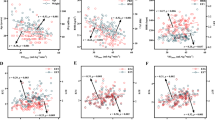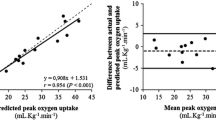Abstract
Purpose
The aims were to: (1) compare peak oxygen uptake (\( \dot{V}{\text{O}}_{2} \)peak) predicted from four standard equations to actual \( \dot{V}{\text{O}}_{2} \)peak measured from a cardiopulmonary exercise test (CPET) in obese patients with metabolic syndrome (MetS), and (2) develop a new equation to accurately estimate \( \dot{V}{\text{O}}_{2} \)peak in obese women with MetS.
Methods
Seventy-five obese patients with MetS performed a CPET. Anthropometric data were also collected for each participant. \( \dot{V}{\text{O}}_{2} \)peak was predicted from four prediction equations (from Riddle et al., Hansen et al., Wasserman et al. or Gläser et al.) and then compared with the actual \( \dot{V}{\text{O}}_{2} \)peak measured during the CPET. The accuracy of the predictions was determined with the Bland–Altman method. When accuracy was low, a new prediction equation including anthropometric variables was proposed.
Results
\( \dot{V}{\text{O}}_{2} \)peak predicted from the equation of Wasserman et al. was not significantly different from actual \( \dot{V}{\text{O}}_{2} \)peak in women. Moreover, a significant correlation was found between the predicted and actual values (p < 0.001, r = 0.69). In men, no significant difference was noted between actual \( \dot{V}{\text{O}}_{2} \)peak and \( \dot{V}{\text{O}}_{2} \)peak predicted from the prediction equation of Gläser et al., and these two values were also correlated (p = 0.03, r = 0.44). However, the LoA95% was wide, whatever the prediction equation or gender. Regression analysis suggested a new prediction equation derived from age and height for obese women with MetS.
Conclusions
The methods of Wasserman et al. and Gläser et al. are valid to predict \( \dot{V}{\text{O}}_{2} \)peak in obese women and men with MetS, respectively. However, the accuracy of the predictions was low for both methods. Consequently, a new prediction equation including age and height was developed for obese women with MetS. However, new prediction equation remains to develop in obese men with MetS.

Similar content being viewed by others
References
Finucane MM, Stevens GA, Cowan MJ, Danaei G, Lin JK, Paciorek CJ, Singh GM, Gutierrez HR, Lu Y, Bahalim AN, Farzadfar F, Riley LM, Ezzati M (2011) National, regional, and global trends in body-mass index since 1980: systematic analysis of health examination surveys and epidemiological studies with 960 country-years and 9.1 million participants. Lancet 377(9765):557–567
Alberti KG, Eckel RH, Grundy SM, Zimmet PZ, Cleeman JI, Donato KA, Fruchart JC, James WP, Loria CM, Smith SC (2009) Harmonizing the metabolic syndrome: a joint interim statement of the International Diabetes Federation Task Force on Epidemiology and Prevention; National Heart, Lung, and Blood Institute; American Heart Association; World Heart Federation; International Atherosclerosis Society; and International Association for the Study of Obesity. Circulation 120(16):1640–1645
Ford ES (2005) Risks for all-cause mortality, cardiovascular disease, and diabetes associated with the metabolic syndrome: a summary of the evidence. Diabetes Care 28(7):1769–1778
Katzmarzyk PT, Leon AS, Wilmore JH, Skinner JS, Rao DC, Rankinen T, Bouchard C (2003) Targeting the metabolic syndrome with exercise: evidence from the HERITAGE Family Study. Med Sci Sports Exerc 35(10):1703–1709
Kubilius R, Jasiukeviciene L, Grizas V, Kubiliene L, Jakubseviciene E, Vasiliauskas D (2012) The impact of complex cardiac rehabilitation on manifestation of risk factors in patients with coronary heart disease. Medicina 48(3):166–173
Tjonna AE, Lee SJ, Rognmo O, Stolen TO, Bye A, Haram PM, Loennechen JP, Al-Share QY, Skogvoll E, Slordahl SA, Kemi OJ, Najjar SM, Wisloff U (2008) Aerobic interval training versus continuous moderate exercise as a treatment for the metabolic syndrome: a pilot study. Circulation 118(4):346–354
American College of Sports Medicine: ACSM (1998) ACSM Position Stand. The recommended quantity and quality of exercise for developing and maintaining cardiorespiratory and muscular fitness, and flexibility in healthy adults. Med Sci Sports Exerc 30(6):975–991
Stringer WW (2010) Cardiopulmonary exercise testing: current applications. Expert Rev Respir Med 4(2):179–188
Evans HJ, Ferrar KE, Smith AE, Parfitt G, Eston RG (2015) A systematic review of methods to predict maximal oxygen uptake from submaximal, open circuit spirometry in healthy adults. J Sci Med Sport 18(2):183–188
Noonan V, Dean E (2000) Submaximal exercise testing: clinical application and interpretation. Phys Ther 80(8):782–807
Arena R, Myers J, Williams MA, Gulati M, Kligfield P, Balady GJ, Collins E, Fletcher G (2007) Assessment of functional capacity in clinical and research settings: a scientific statement from the American Heart Association Committee on Exercise, Rehabilitation, and Prevention of the Council on Clinical Cardiology and the Council on Cardiovascular Nursing. Circulation 116(3):329–343
Coquart JB, Eston RG, Grosbois J-M, Lemaire C, Dubart AE, Luttenbacher D-P, Garcin M (2010) Prediction of peak oxygen uptake from age and power output at RPE 15 in obese women. Eur J Appl Physiol 110(3):645–649
Coquart JB, Lemaire C, Dubart A-E, Douillard C, Luttenbacher D-P, Wibaux F, Garcin M (2009) Prediction of peak oxygen uptake from sub-maximal ratings of perceived exertion elicited during a graded exercise test in obese women. Psychophysiology 46(6):1150–1153
Gläser S, Koch B, Ittermann T, Schäper C, Dörr M, Felix SB, Volzke H, Ewert R, Hansen JE (2010) Influence of age, sex, body size, smoking, and beta blockade on key gas exchange exercise parameters in an adult population. Eur J Cardiovasc Prev Rehabil 17(4):469–476
Hansen JE, Sue DY, Wasserman K (1984) Predicted values for clinical exercise testing. Am Rev Respir Dis 129(2):49–55
Riddle W, Younes M, Remmers J, deGroot W (1980) Graphical analysis of patient performance in the pulmonary function laboratory. Proc Annu Symp Comput Appl Med Care 5(1):283–290
Wasserman K, Hansen JE, Sue DY, Stringer WW, Whipp BJ (2005) Principles of exercise testing and interpretation. Lippincott Williams and Wilkins, Philadelphia
Török K, Szelenyi Z, Porszasz J, Molnar D (2001) Low physical performance in obese adolescent boys with metabolic syndrome. International journal of obesity and related metabolic disorders. Int J Obes Relat Metab Disord 25(7):966–970
Yu R, Yau F, Ho SC, Woo J (2013) Associations of cardiorespiratory fitness, physical activity, and obesity with metabolic syndrome in Hong Kong Chinese midlife women. BMC Public Health 13:614
Fletcher GF, Balady GJ, Amsterdam EA, Chaitman B, Eckel R, Fleg J, Froelicher VF, Leon AS, Pina IL, Rodney R, Simons-Morton DA, Williams MA, Bazzarre T (2001) Exercise standards for testing and training: a statement for healthcare professionals from the American Heart Association. Circulation 104(14):1694–1740
Lorenzo S, Babb TG (2012) Quantification of cardiorespiratory fitness in healthy nonobese and obese men and women. Chest 141(4):1031–1039
Ng M, Fleming T, Robinson M et al (2014) Global, regional, and national prevalence of overweight and obesity in children and adults during 1980–2013: a systematic analysis for the Global Burden of Disease Study 2013. Lancet 384(9945):766–781
Saltiel AR, Kahn CR (2001) Insulin signalling and the regulation of glucose and lipid metabolism. Nature 414(6865):799–806
Morinder G, Larsson UE, Norgren S, Marcus C (2009) Insulin sensitivity, VO2max and body composition in severely obese Swedish children and adolescents. Acta Paediatr 98(1):132–138
Balkau B, Valensi P, Eschwege E, Slama G (2007) A review of the metabolic syndrome. Diabetes Metab 33(6):405–413
Acknowledgments
The authors thank Mr Alain Boutry for his valuable help in practicing the exercise tests and for the data collection.
Author information
Authors and Affiliations
Corresponding author
Ethics declarations
Conflict of interest
The authors declare that they have no conflict of interest.
Ethical approval
The study was approved by the local ethical committee for participant’s protection in clinical research of Sud Mediterranee in France.
Informed consent
All participants have signed written informed consent forms.
Rights and permissions
About this article
Cite this article
Debeaumont, D., Tardif, C., Folope, V. et al. A specific prediction equation is necessary to estimate peak oxygen uptake in obese patients with metabolic syndrome. J Endocrinol Invest 39, 635–642 (2016). https://doi.org/10.1007/s40618-015-0411-7
Received:
Accepted:
Published:
Issue Date:
DOI: https://doi.org/10.1007/s40618-015-0411-7




